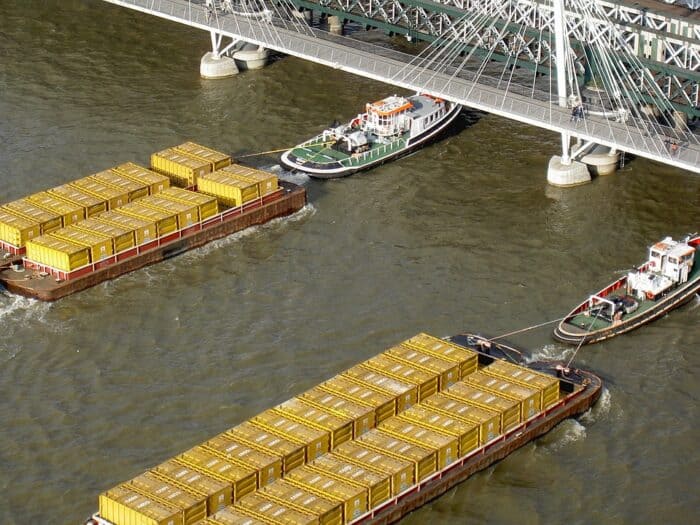What is a Barge?
A barge is a large, very long, flat bottom vessel usually used to transport large or numerous things along inland waterways. This can be anything from shipping containers to passengers and even trash. You will chiefly find them along rivers, canals and other inland waters rather than out on the open sea.
One of the most defining and necessary features of a barge is that flat bottom like the much smaller jon boat.
What’s the Difference Between a Boat and a Barge?

The main difference between a barge and most any boat on the water is that barges are rarely ever self propelled vessels. You can think of them more like the large trailers pulled by semi-trucks on highways. Some barges are designed to be self propelled and thus have a pilot house, an engine and so on. Many cargo barges, however, are either pulled by tugboats or more often pushed along by pusher boats.
A similar style of vessel might be a massive cargo ship or a large ferry but those vessels are always self propelled. Cargo ships, which can be very long and relatively flat like a barge, are designed for ocean crossing as well. Barges are not. Ferries used to transport people and vehicles from one point to another typically follow a fairly short route across bays, lakes and harbors and such, unlike barges which usually follow longer and slower routes.
Because inland waters are typically rather shallow, a barge makes more sense than a large boat which can’t fit in many places that a barge can get to. This is why they are still in common usage.
What is the Purpose of a Barge?

Barges are a relic of a bygone era that are still useful but demonstrate their origins and intended purpose well. A long time ago the most efficient way to transport goods, especially large quantities of goods or heavy items, was on the water. Before airplanes, before highways, you needed to travel along inland waterways to travel the country. A barge made that possible.
Because they are wide and long and flat, a barge could travel canal locks and rivers even in shallower conditions that a much bigger vessel with a large draft could never handle.
The purpose of a barge originally was simply one of efficiency. Water made it easier to move quantities of large things. Early barges were essentially big rafts and they even used horses and draft animals on the shore to pull them via ropes down river.
Later it became easier to use a smaller, powerful vessel like a tug to pull the barge or push it from behind.
Transporting Cargo
Barges can carry a diverse range of products. Barges carrying liquid cargo may haul oil and petrochemicals. Dry bulk cargo barges may ferry dry cargo ranging from grains and foods to raw steel, coal, and more. Some barges are even outfitted with equipment like cranes so construction work can be done from on the water for things like bridges, oil rigs and so on.
Specific Inland Waterways
Many barges in use today are waterway specific. That is to say a barge may be designed to work in a very specific canal or river and it may not ever work outside of that waterway. This can happen because the waterway has a certain depth or the passages are a certain length and the barge needs to be custom designed to fit in that area. You can imagine that a generic barge of a certain length, width and displacement may work really well in the Mississippi River, for instance, but could be much too big to work in a smaller river.
Other Uses
Royal barges are actually still a thing, though obviously far less common. They’re used for ceremonial purposes and have a long history everywhere from England to Egypt to Thailand.
You can also find a barracks barge which is like a house boat, a split hopper barge for dredging, car float barges for transporting vehicles. There are also marine barges used for barge cruises which don’t have the load carrying capacity of their larger cousins, and of course the party barge.
How Big is a Barge?

A modern barge may be as long as 150 to 200 feet and maybe 35 feet across or more with 195 feet be the most common size. They have the capacity to carry cargo weighing as much as 1,500 tons which is an incredible weight. It is unlikely you’d find many boats capable of handling that much weight that are also able to navigate the inland waters a barge will travel down.
In Europe, many barges are far more narrow than the large river barges you’ll find in America. The canals and locks in Europe tend to be small so these narrow boats may only be 7 feet across in order to navigate them. Shipping barges in Europe that travel larger rivers can be 251 feet in length and capable of carrying 2,450 tons of cargo.
The largest barges will reach about 300 feet in length and can carry as much as 8,000 metric tons of cargo.
There are at least 26,000 cargo barges operating today, and several thousand more outfitted for liquid cargo. A barge is able to carry 15 times more cargo than a railway car and 60 times more than a truck. Not only that but barges can be strung together in a flotilla which can include up to a dozen or more barges in a line, all being pushed or pulled by one or two tug boats. This makes them incredibly efficient in terms of fuel consumption compared to how much product they can move.
Why is it Called a Barge?

The word “barge” is certainly a little confusing at first glance since it has no obvious meaning or relation to boating. Barges are remarkably old vessels, however, so the origin of the name stretches back to well before English. In fact, the first barges we can point to in history came from Ancient Egypt in around 2,500 BC.
Back then, the Pharaoh Khufu had a barge built to ferry him to the afterlife, so they had pretty lofty origins. After that, Romans used barges as well though they still didn’t have that specific name.
It wasn’t until around the year 1300 that the word “barge” first emerged. It comes from the Latin word “barga” which just referred to any small boat. The flat bottomed shipping vessel meaning of the word showed up around 1480.
How Do Barges Stay Afloat?

Like any boat, a barge manages to stay afloat thanks to physics. Buoyancy is what allows any vessel to float on water and the principle states that the force exerted on an object in a fluid is equal to the weight of fluid displaced (moved out of the way) by the object. In other words, the water pushes up as the boat pushes down.
Gravity pushes anything in the water, including a barge, down. Buoyancy pushes back up. So it’s a little battle between the two forces. If gravity wins, the object sinks. If buoyancy wins, it floats. If the object weighs less than the water it displaces, it floats. Boats, which have space inside of them that is filled with air, will displace a lot of water but weigh less than that water so they can stay afloat. A rock, on the other hand, displaces little water relative to its weight so it can’t stay afloat.
A barge, with its long, flat bottom, manages to take advantage of these buoyant forces really well and as a result can carry huge amounts of weight without sinking.
The Bottom Line
A barge is a very long, relatively narrow flat bottom vessel that is chiefly used to transport extremely heavy cargo. They have the ability to carry thousands of tons of cargo and they do so along inland water routes in a way that is incredibly cost-effective for businesses that use them. Few barges are self propelled power barges though some may be. More commonly barges are either pulled by tugboats or pushed by pusher boats which means that a barge is usually a very fuel efficient method of transporting goods, though it’s not always the fastest. Barge transport is cost effective as well.
Though they are less common today, there are still tens of thousands of barges in use all around the world.
Categories: Boats











